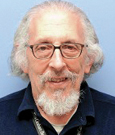Many of the advances that have bettered mankind are attributed to those who were driven by a primary passion. Geoffrey P. Herzig, MD, lived the better part of his life with a primary passion: conducting research to increase the cure rate of leukemia and lymphoma patients. His friend and colleague, Robert Peter Gale, MD, PhD, who has contributed greatly to basic science and clinical research in bone marrow transplantation, commented, “If you’re a young physician who does bone marrow transplants or treats people with leukemia, you may not realize how much you and your patients owe to Geoff Herzig.”
Dr. Herzig was born on December 6, 1941, the day before Japan launched its infamous strike on Pearl Harbor, signaling the beginning of World War II. He and his brother Roger had an itinerant childhood, growing up in Cincinnati, Cleveland, and Georgia. Dr. Herzig attended the University of Cincinnati, where he graduated with honors in chemistry. He then pursued a career in medicine at the Case Western Reserve University School of Medicine in Cleveland.
Roger, several years younger, would attend the same medical school, and he frequently tells a story about his interview for admission. The dean had his and his older brother’s files on his desk. The dean cut the interview short, asking Roger whether he was as smart as Geoff, who was by then the brightest student in his class and a member of the medical honor society Alpha Omega Alpha. Roger’s reply: “Not as smart but a lot more normal.” He was accepted the next day.
Early Cryopreservation Efforts
After receiving his medical degree, Dr. Herzig did his internship and residency at Albert Einstein College of Medicine in New York. Following his residency, he trained in hematology and oncology at the National Cancer Institute and later at Washington University in St. Louis, where he joined the faculty.
While at Washington University, he further developed his concept of using high doses of anticancer drugs in leukemia, whose dose-limiting toxicity was bone marrow suppression, which he could overcome with an autologous transplant. However, the bone marrow cells needed to be cryopreserved at an appropriate time before the side effects of multiple cycles of chemotherapy. To accomplish this, the ever-inventive and extremely handy Dr. Herzig built his own cryopreservation device.
Gordon L. Phillips, MD, Dr. Herzig’s mentee, colleague, and friend added some clarity to these early efforts in cryopreservation. “Geoff did not invent cryopreservation of bone marrow, but he worked diligently to perfect the process at a time well before computerized, rate-controlled freezing. He also created the ‘software’ (long before this word was widely used), hand-calibrating the freezing curve and putting some of the machinery in one of his old cigar boxes,” he recounted.
“One of my most enduring memories is of Geoff working late in the lab, refining the ‘software,’ smoking a cigar, and cursing (mildly and softly) at his slow progress. Finally, we ‘perfected’ it—meaning it was usable—but it was very labor-intensive and nerve-wracking as Geoff and I froze our first marrows together,” Dr. Phillips continued.
His associates, Dr. Gale and renowned leukemia expert Clara D. Bloomfield, MD, recalled a 1973 study conducted by Dr. Herzig in which he described attempts to rescue Rhesus monkeys with early acute graft-vs-host disease by destroying the graft and infusing frozen autologous bone marrow. His work provided insights for future work in preventing fatal graft-vs-host disease.
Transplant Program Director
In 1975, Dr. Herzig founded the adult bone marrow transplant program at Barnes Hospital, one of the earliest programs of its type in the country. And in 1980 he was named first Director of Washington University’s Bone Marrow Transplant Program. In 1991, Dr. Herzog, along with others including Dr. Bloomfield, joined Roswell Park Cancer Institute in Buffalo, NY, to concentrate on clinical trials in acute leukemia, particularly his special interest, acute myeloid leukemia (AML).
When Dr. Herzig was at Roswell Park, he worked closely with Dr. Bloomfield to define the predictive role of cytogenetics and molecular abnormalities in predicting AML therapy outcomes. He was also an important contributor to evolving concepts in how to best treat Hodgkin lymphoma, including novel drug regimens and autologous transplants.
After a 20-year marriage, Dr. Herzig lived as a bachelor, which, as colleagues pointed out, suited his quirky, introspective personality. He was an avid sailor, keeping a boat in New York Harbor. A man of interesting contradictions, he could be a very demanding mentor, but hundreds of mentees remember an underlying gentleness and random acts of kindness.
He is survived by his son Andrew, his grandchildren, and his brother Roger, who is a Professor of Hematology at the University of Louisville and the Director of the University’s Blood and Bone Marrow Program.


